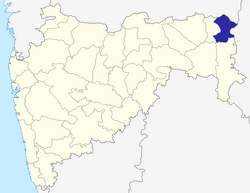Gondia district
|
Gondia district गोंदिया जिल्हा |
|
|---|---|
| District of Maharashtra | |
 Location of Gondia district in Maharashtra |
|
| Country | India |
| State | Maharashtra |
| Administrative division | Nagpur Division |
| Headquarters | Gondia |
| Tehsils | 1. Gondia, 2. Goregaon 3. Tirora, 4. Arjuni Morgaon, 5. Deori, 6. Amgaon, 7. Salekasa, 8. Sadak Arjuni |
| Government | |
| • Lok Sabha constituencies | 1. Bhandara-Gondiya shared with Bhandara district, 2. Gadchiroli-Chimur (shared with Gadchiroli and Chandrapur districts) |
| • Assembly seats | 4 |
| Area | |
| • Total | 4,843 km2 (1,870 sq mi) |
| Population (2001) | |
| • Total | 1,200,151 |
| • Density | 250/km2 (640/sq mi) |
| • Urban | 11.% |
| Demographics | |
| • Literacy | 67.6% |
| • Sex ratio | 1005 |
| Average annual precipitation | 1197 mm |
| Website | Official website |
Gondia district (Marathi: गोंदिया जिल्हा), also known as Gondiya district, is an administrative district in the state of Maharashtra in India. The district headquarters are located at Gondia (Gondiya). The district occupies an area of 5,431 km² and has a population of 1,200,707 of which 11.95% were urban (as of 2001). The district is part of Nagpur Division.
The region to the south of the Godavari was inhabited by the aborigines, who are called Rakshasas in the Ramayana where the region is mentioned. Initially the district was included in the seventh century in the territories of the Haihaya Rajput kings of Chhattisgarh whose kingdom was known as Maha Kosala. Gondia or Gondiya was a part of Bhandara retains some recollection of Hindu kings who ruled from Nagardhan. The 12th century saw the rule of Panwars (Rajput) who were subsequently ousted by Gond chiefs who asserted their independence of the Ratanpur dynasty. This was followed by Raghoji Bhonsle of Vidarbha who established himself as the king of Vidarbha in 1743. In 1755, Janoji was declared as the sovereign of the territory, after the death of his father Raghoji Bhonsle. The two brothers Mudhoji and Rupaji of Raghoji Bhonsle of Hingani-Beradi were contemporaries of Shahaji, the father of Chhatrapati Shivaji and one of the ancestors of the Bhonsles of Nagpur who rehabilitated the village of Beradi was probably the contemporary of Maloji, the grandfather of Chhatrapati Shivaji. After the death of Sambhaji, during the Mughal-Maratha conflict, Parasoji rendered invaluable help to Rajaram who had succeeded to the throne of Chhatrapati. The territories of Vidarbha and Berar from which he had exacted tribute were given to his charge under a grant made in 1699 A.D.
In 1707 after the death of Aurangzeb when Shahu was released by Muhammad Azam, Parasoji Bhonsle was the first of the Maratha nobles to join him in west Khandesh.
The 17th century saw the invasion of the Peshwas who were instrumental in making the district a part of Berar. The Peshwas were succeeded by the Nizams during the 1850s; the Nizam ceded Berar to the British East India Company. In 1903 the Nizam leased Berar to the British Government of India. It was transferred to the Central Provinces. In 1956, with the re-organization of states, Bhandara was transferred from Madhya Pradesh to Bombay Province and in 1960 with the formation of Maharashtra; it became a district of the state and was carved out of Bhandara district in 1999.
...
Wikipedia
